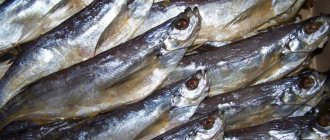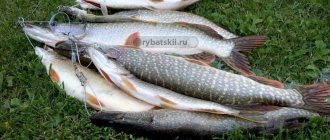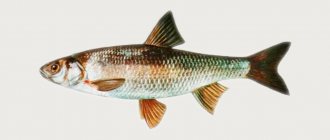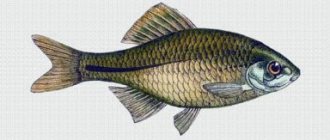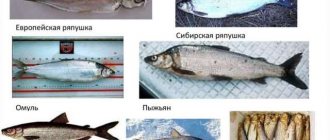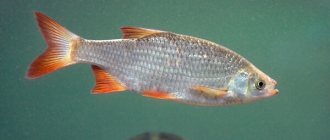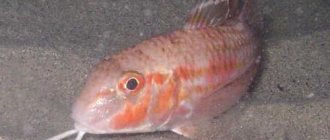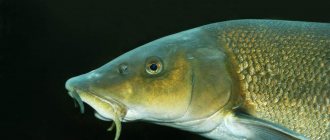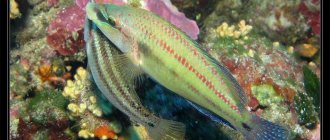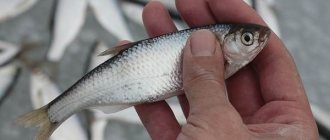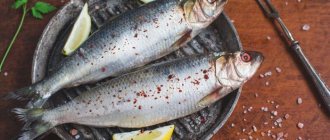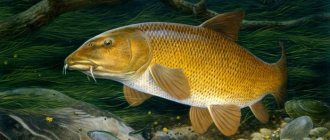Chekhon fish: description and photo
Chekhon is a fish with an elongated saber-shaped body. This is why fishermen call it “Sabre”. The back is greenish, the lateral line on the lower fins is red. The tail and fin are gray with a silver tint. The taste is excellent. Moderately greasy without any specific odors. This is a real storehouse of protein, nutrients and vitamins. Dried and smoked are especially good. The meat is hypoallergenic, so it can be given to children after removing all the bones. The average weight of one individual is 0.4-0.5 kg. Some specimens grow up to 0.7 meters, reaching a mass of 0.9 kg.
The most common habitats are bodies of water (rivers, reservoirs) in the basins of the Baltic, Azov and Black Seas. Prefers deep water with a strong current, found near reaches and slopes, and lives in flocks.
The strategy for catching saberfish depends on the season. In the summer, huddled in flocks, the saber stays in deep-water areas with active water exchange, near underwater boulders and sunken trees. Also lives in places where the branches of bushes or trees are inclined towards the water.
In winter it hides at the bottom, choosing areas with slow currents. For effective fishing, you need to fish the reservoir in several places and change the point often. In winter they fish only from the ice, drilling holes in the middle of the reservoir. There are simply no bites near the shore during this period.
What to catch saberfish with
Saber fishing is convenient with a wide selection of baits. Their choice is determined by the usual diet on a particular body of water and the time of year. If you don’t have time to deeply study the features of the location, you can use one of the proven options:
- Bloodworm;
- Maggot;
- Worm;
- Wasp;
- Live bait;
- Fly;
- Grasshopper;
- Dragonfly;
- Butterfly;
- Artificial fly;
- Small spinners.
If you plan to fish using a grasshopper, it is better to place it on the hook without legs. They are large and hard and will interfere with swallowing the bait. Bleak fry are suitable as live bait. The size of the fry should be no more than four centimeters. Preferably 2 centimeters, so that not only large, but also medium-sized individuals are caught. During the spawning period, the fish show increased activity; even a bright thread is suitable for bait, but this is a last resort.
What does the sabrefish bite on in November?
For effective fishing, you should know what saberfish bite on in November . When fishing with spinning rods and fly fishing gear, artificial baits are used. Fly fishing has proven itself to be excellent. In November, wet flies and nymphs are used. But if a bombard is used, then flies with any buoyancy are applicable. The main thing is that they imitate the behavior of aquatic insects well.
Suitable for jig fishing using silicone baits. When spinning fishing, sinking wobblers and spoons are used, the size of which should not exceed 5 cm.
Chekhon is unpretentious in choosing food. It bites well on traditional baits: worm, maggot, bloodworm, and for sea fishing you can additionally use nereis (sea worm).
Proper preparation of gear, lures and lures, as well as persistence while searching for sabrefish, ensures effective fishing.
Tackle for sabrefish
The choice of gear for catching sabrefish depends on the reservoir, personal preferences, season and other factors. However, there are several basic universal tips that will help make fishing more effective:
- Gear must be of good quality and selected for the season.
- Active fish often tear the equipment, so it’s a good idea to take a spare shock absorber and rubber band with you.
- A prerequisite is the presence of ready-made leashes connected by swivels. A soft leash is not used, since the saber tries to twist the tackle. Hard fishing also does not give a good result, since the soft lips of the fish are easily torn. We need to look for a compromise option.
- If the bite is bad, you can change the depth of lowering the tackle. As a rule, this gives results.
- It is better to fish from a boat, since long casts of gear will be required, and the Czech fish does not often approach the shore.
In autumn and spring, the fish prefers to stay in the middle layers of water, going deeper at night. There the temperature is more stable. In the off-season, catching sabrefish using bottom tackle is effective. In summer, when the water warms up and the fish rise to the surface, you can use a float rod. Among the effective types of fishing are the following:
- to the bombard;
- to the feeder;
- with an elastic band;
- on a float rod;
- for spinning.
Each of them showed itself positively at different times of the year and on different bodies of water. To choose the optimal gear, you need to study the features of the water location.
Catching sabrefish using a bombard
The specificity of fishing with a bombard is that you need to carefully choose a place for fishing and choose the right float. A bombard is a sinker that is strung on a fishing line with bait placed on it. Insects or small fish are most often used as the latter. It is best to fish with a bombard in the summer. The optimal places are near rifts and slopes. The equipment set includes:
- rod up to 6 m long;
- float (50 grams);
- inertia coil;
- fishing line 0.2-0.25 mm;
- 18 meter braided line;
- two-meter fluorocarbon leash;
- hooks No. 17-19;
- swivel
Catching sabrefish with a bombard is carried out using small suspenders that move the equipment. The movements should be smooth, but sufficient to hook the fish. The bait in the water should resemble the natural movement of a bug or fly. Despite all the caution and timidity of this species, the catch with bombard is very good (this is noticeable in the video).
Fishing with sbirulino (bombard) video:
On a float rod
The most productive fishing occurs in the early morning. During this period, the sabrefish hunts for aquatic midges and small fish. She announces her presence with characteristic splashes on the water. If they are there, it means the place has been chosen correctly and there will be a catch. An ordinary annelid worm or maggot is suitable as bait. The most catchy ones are considered to be: grasshopper, fly and wasp. It’s not difficult to get such bait in the summer.
For example, to catch a wasp, leave a glass jar outside, coated with jam inside. After a few hours, a sufficient number of insects will gather in it. Pour boiling water into the jar and close the lid. Free bait for sabrefish is ready. Unlike worms, the wasp is dense and does not knock it off the hook. You can catch several individuals with one insect.
Fishing with a float rod does not require deep skills. The main thing is to prepare fishing gear and take consumables with you. The fisherman will need:
- Rod 4-7 meters;
- fishing line 0.18 mm thick.
- Preferably a reel that can hold at least 50 meters of fishing line;
- Leash up to one and a half meters with 1-3 hooks;
- sinker and float.
You can use bamboo with a fixed long fishing line, but the result will be poor. The fact is that catching sabrefish with a float rod has its own peculiarities. The float is only needed to fix the depth. In our case, it does not serve as a bite indicator. During the fishing process, you will need to carry out wiring, playing with bait.
The technology of the process is reminiscent of spinning fishing. First, a careful cast is carried out. Next, the line on the reel is released, and the float is removed further downstream. When the bait is a sufficient distance away, you can begin to pull the bait, imitating the play of the fly.
The sabrefish is a schooling and active fish. It doesn’t stand in one place. It quickly changes location and depth. During fishing, the sinker needs to be moved, experimenting with depth. With the right approach, it is possible to catch up to two fish in one trip.
Chekhon spawning
Spring laying of eggs occurs simultaneously over 3-4 days at a water temperature of +12-130 C (April-June). This process is accompanied by a maximum rise in the level of flood waters and mass migration of saberfish into river beds over fairly long distances. The usual depth of spawning grounds is 1-3 meters. It is also important to have a strong current, which will provide the masonry with a constant flow of oxygen. That is why sabrefish in reservoirs spawn exclusively at the mouths and sources of rivers.
To learn more:
Salmon is a red fish from the salmon family.
Unlike other fish of the carp family, young females aged 3-5 years are the first to begin spawning. Then comes the turn of the adults, who come out to the spawning shallows under the camouflage of the morning fog. The initial size of the egg is 2-2.5 mm, but thanks to a special spongy coating it quickly absorbs water, increases in diameter to 4-5 mm and acquires moderate buoyancy. This natural mechanism allows the masonry to move freely in the water column and receive the required amount of oxygen.
After 3-5 days, the process of hatching of larvae begins, which flock into flocks and slowly migrate downstream. In water, sabrefish fry intensively feed on zooplankton and during the first year of life they grow up to 7-10 cm in length. High speed and innate caution contribute to the survival of most of the clutch. This is all the more important because artificial breeding of saberfish is rarely practiced due to the complexity of the incubation period of the eggs. After spawning is completed, the sabrefish that came from salt water rolls back into the sea. Part of the river population may also follow it to feed.
Garland for saberfish
A garland is a fishing line with a sinker, to which five leashes with hooks are attached. The number of leashes may be greater. The main thing is that they do not get confused causing inconvenience. The garland is attached to a spinning rod, which allows for long casting. Feeder fishing with a garland requires taking into account a number of factors:
- current intensity in a reservoir;
- weather features;
- weight of the feeder (up to 60 grams).
How to mount a garland - video:
Bait should be supplied to the fishing site regularly. To simplify fishing, use a 2-meter leash, and also equip the fishing rod with foam balls. The feeder should not be too heavy so that it sinks to the bottom gradually when casting. You should not compact the complementary food too much so that it is washed out in the water column easily and gradually. Crumbly porridge is used as bait, and maggots are used as bait.
The fishing technique is as follows. After a fishing spot has been chosen, the fishing point is fed by making 5 to 10 casts with a large-diameter feeder filled with bait. This allows you to feed the point faster. The next stage is casting gear with hooks and bait. Casting is not very convenient due to the long leashes, but you quickly get used to it.
Feeder tackle (garland) for catching saberfish - video:
Catching sabrefish with an elastic band
Donka-elastic band is a simple tackle made from a fishing line with leads and a long elastic band. One of the features is the cost. Any fisherman can buy or make such tackle. There is no need to purchase an expensive spinning rod and reel. Equipment includes:
- reel;
- 50-meter fishing line;
- meter carabiner with elastic swivel;
- leash;
- sinker.
You can catch sabrefish using an elastic band both from a boat and from the shore. Bait: grasshoppers, fry, worms, maggots. The fishing line with hooks must be pulled towards you periodically to attract fish to the bait. When fishing with an elastic band, the tackle is kept in the middle layers of the water.
A weight is tied to one end of the elastic band. A fishing line with leashes is attached to the other. The number of leashes is not limited. The tackle is thrown into the water, and when biting it is simply pulled towards you with your hands. Next, they remove the fish, adjust the bait and loosen the line. The elastic band itself returns the tackle with hooks to the water. This method saves effort and time, freeing the fisherman from the need to cast. An important condition is a heavy load that will not move along the bottom after each haul. The technique is not particularly complicated:
- install the tackle so that the hooks are placed in the right place;
- feed the fishing area;
- periodically twitch the line, creating a game with bait;
- When there are distinct bites, sharply pull the line towards you.
The fishing strategy depends on the weather. On a cloudy day, the sabrefish tackle is lowered about one and a half meters closer to the bottom of the reservoir. If the weather is sunny, then the equipment remains on the surface. At the same time, it is important to look for algae, since there is a risk of fishing line snagging, which means the fishing will be ruined.
Fishing with an elastic band - video
Habits and lifestyle of saberfish
This species is a valuable semi-anadromous schooling fish that spends a lot of time in estuarine areas rich in food. It is not uncommon to see sedentary river and sea forms of saberfish, which do not differ from each other in any way except for the growth rate and color of the back. But in any case, the fish spawns exclusively in fresh water, often upstream for many hundreds of kilometers.
To learn more:
Burbot: what kind of fish is this?
The favorite habitats of saberfish are medium and large bodies of water with an abundance of deep and spacious places without dense vegetation. Most often these are large rivers, lakes or reservoirs with complex bottom topography and numerous holes, which serve as a natural night shelter or a place for long-term hiding in bad weather, heat, and severe frosts.
The main activity occurs in the late morning, daylight and early evening. This is due to the feeding habits of sabrefish, which prefers to hunt fry and insects in the middle layers or near the surface of the water. The fish is quite cautious and very rarely swims to the shore or goes into shallow water. But if you deliver the bait to the school’s feeding area using long-range gear or from a boat, you can expect a bold and confident bite. At great depths of 5-30 meters, the mower behaves carelessly. Even the noise of the struggle of a relative caught on a hook does not frighten him. This is explained by the fact that one of the favorite hunting methods of saberfish is catching insects in flight. To do this, she jumps high out of the water and then falls back with a loud splash.
If there are rapids or rapids on the river, depth ceases to be of key importance. Such places attract fish, which, thanks to their excellent maneuverability and stability, can deftly snatch helpless fry, insects, and aquatic invertebrates from a fast flow. In autumn, in September, saberfish begin to feed intensively, and then gradually migrate to deeper places, preparing for wintering. In the cold season, it remains quite active and can be caught well on the ice.
Where to catch saberfish
This fish prefers space. It cannot be found in small ponds overgrown with grass. There are 2 types: sea and freshwater. Marine is found in seas such as the Black, Azov, Baltic, as well as in some salt lakes. The freshwater fish sabrefish is found in large rivers: the Danube, Dnieper, Don, Dniester, Volga, and freshwater lakes (Ilmen, Onega, Ladoga). Due to too intensive fishing, the number of this fish has decreased significantly. In the Bryansk region, on the Seversky Donets, fishing is strictly regulated.
Finding a suitable body of water is not the key to success. You need to understand where the jamb is. As a rule, these are places near boulders and snags under water. On rivers, you should look for saberfish at the junctions of strong and weak currents. In summer, it quickly reveals itself by rising to the surface of the water and playing in the sun. At night it goes to the bottom, so daytime and night fishing are different.
Where does the saberfish live?
Photo: Chekhon in the river
Chekhon loves space and expanse, which is why it chooses wide and deep bodies of water, found in large river systems and reservoirs. The fish is widely distributed from the Baltic to the Black Sea basin. The favorite water areas for sabrefish are: Ladoga, lakes Ilmen and Onega, the Gulf of Finland, the Svir and Neva rivers - this all applies to the northern regions of fish habitat.
In the southern part of its range, the saberfish has chosen the river systems of the following seas:
- Azovsky;
- Caspian;
- Aralsky;
- Black.
Chekhon is a fish of numerous fresh water bodies, located both in Asia and in the vast expanses of Europe, the fish inhabits:
- Volga;
- Bug;
- Dnieper;
- Kuru;
- Kuban;
- Don;
- Terek;
- Syrdarya;
- Amu Darya.
As for the reservoirs of other countries, saberfish are found in Poland, Bulgaria, Sweden, Finland, Austria, Germany, and Hungary. Flocks of saberfish are located in deep places of lakes, rivers and reservoirs. The slave loves running water, choosing the widest areas of reservoirs with uneven bottoms and a large number of holes. The mobile sabrefish deftly maneuvers in the waters, moving in whole schools, swimming to the coastal zone only during feeding.
Interesting fact: Most often, saberfish occupy the middle water layers.
The fish also try to avoid areas intensively overgrown with aquatic vegetation and muddy places, and at night they go deeper.
Fishing for sabrefish on the Don
The Don is an ideal place for fishing. The river current is strong, the climatic conditions are suitable (hot summers, mild winters), and the food supply is excellent. The best places are considered to be near the Donskoy and Vetryachiy farms, not far from the confluence of such rivers as the Khoper, Chir, Bogucharka, and Medveditsa into the Don.
Good conditions for fishing near the city of Kalach-on-Don. There are also fishing spots near the villages of Shilovo, Krivoborye, Medovka in the Voronezh region. The only drawback of these places is that they are well known, and you need to occupy fishing areas in advance.
In the warm season, natural baits are used in the form of a worm, bloodworms and maggots. With proper wiring, artificial flies also give an effect. It makes sense to use complementary food only in places without current, but the saber rarely swims there. It is better to concentrate on the selection of gear, bait and wiring strategy.
Chekhonian biting calendar
| January | February | March | April | May | June | July | August | September | October | November | December |
| — | — | + | +++ | + | +++ | +++ | +++ | + | + | — | — |
| January | Catching sabrefish in January is more of a success, the bite is very bad. |
| February | The saberfish is starting to stir a little, but don’t expect a bite |
| March | This month, the saberfish begins to wake up after hibernation |
| April | As the water warms up, the fish have almost come out of hibernation, and there is a spring rush before spawning. |
| May | Simultaneously with spawning, the bite improves and fishing approaches the maximum level |
| June | Fishing for sabrefish is entering its maximum stage; steamed grains of wheat and oats, and bread crumbs are actively used as bait. |
| July | Peak fishing continues, warm water and sunny weather have a beneficial effect on fish |
| August | The stability of the bite begins to be disrupted; the best results are expected before a thunderstorm or rain. |
| September | This month it is possible to catch large sabrefish using bait in the form of maggots, hominy, and worms |
| October | The biting activity begins to noticeably weaken, but the chances of leaving with an acceptable catch remain |
| November | As the water gets colder, sabrefish gather in flocks for wintering and go deeper into bottom holes |
| December | The fish goes into hibernation and stays at depth, the chances of catching are almost 0 |
Up
Fishing for sabrefish on the Volga, in Astrakhan
The best conditions for fishing in the Lower Volga. Here you can catch both relatively small riding schooling fish and large specimens. The saber prefers places close to the shore, with great depths, whirlpools and average current speed. The joint makes its presence known in bursts.
The location of schooling fish can be recognized by the concentration of seagulls. This is a sure sign that the saber is actively hunting small fish. The best time for fishing is from spring until the onset of severe autumn frosts. Wasps, grasshoppers, and flies are used as bait. The most preferred types of gear are a float rod or a spinning rod.
The minimum permitted size for catching sabrefish in Astrakhan is 22 cm. All smaller specimens must be released.
Where to look for saberfish in November
Fishing for sabrefish in November makes it difficult to find fish in large areas of freshwater reservoirs and marine expanses, but there is also a positive sign. In November, saberfish gather in large flocks and when found, fishing can be quite productive.
To make it easier to find schools of fish, you should use a fishing echo sounder. After discovering the location of the fish, there is no need to make sudden movements when landing the fish for 2 reasons: firstly, so as not to scare the fish, and secondly, so as not to tear the weak lips of the sabrefish.
Catching sabrefish in winter
In winter, activity is minimal. The fish chooses deeper places for wintering. The favorite wintering place is holes up to 15 meters deep. At the same time, it takes a position a meter from the bottom. It also winters in long, wide underwater ditches and deep reaches. In frosty weather it sits out in the depths and is difficult to tempt it to bite.
When thaws occur, sabrefish fish come closer to the surface. For winter fishing, use a garland or jig. It is recommended to change holes frequently, without staying on one for a long time. In the cold season, the main task is to find where the joint is located. The advantage of fishing with a garland is that you can quickly determine the optimal horizon. The jig is mobile and compact, but it is only effective when the fish comes closer to the surface. The secrets of successful winter fishing are knowledge of the water area of the reservoir, the ability to adapt to the weather and good command of various gear.
When catching saberfish in winter, it is important to follow a few tips:
- The tip of the tackle is equipped with a bright nod, which will be noticeable against the background of white snow.
- The length of the fishing line is selected according to the depth of the reservoir, but it is better to wind it with a reserve. Recommended length from 15 meters.
- The sinker is selected taking into account the strength of the current.
- For bait, maggots, bloodworms, worms or artificial flies are used.
- If there are no bites in one place for an hour, change the hole.
The sleepy saber takes a non-moving bait poorly. The play of the line, smooth and believable, plays an important role. If there is no effect, it is recommended to experiment with the attachment or make a sandwich.
Tackle for catching sabrefish
Gear for catching sabrefish in November from the shore is prepared taking into account long casts and keeping the bait in the bottom layer of water. If weather conditions permit, it is easier to search for saberfish using a boat.
Chekhon in November for spinning
To ensure the casting of light bait over a long distance, a bombard is used. A do-it-yourself bombard is ideal, since when making it yourself, you can always select the desired weight of the equipment, in accordance with the spinning test.
Catching sabrefish in spring
In spring, it gathers in numerous schools on rivers such as the Don and Volga. Found in river tributaries. The main requirements for a reservoir are significant depth and fast current. Trying to find even a single specimen in oxbow lakes, flooded river valleys or shallow lakes is a futile exercise. During the day it stays in the upper and middle water layers, and at night it sinks to the bottom.
April is the month when fish that have safely overwintered in the pits become active. The bite begins after the ice melts. With the onset of the warm season it becomes more intense.
In May, biting activity reaches its peak. Before spawning, which occurs in May and June, sabrefish become especially aggressive, not disdaining any aquatic life. During this period, she excels at using a spinning rod or a donkey with a rubber shock absorber. It comes right to the shore, so catching it is a real pleasure. The most popular bait when catching sabrefish in the spring on a spinning rod is a spinner or wobbler. The so-called “flies” - realistic imitation of insects - have proven themselves well. The behavior of fish in different bodies of water differs, so the behavior of the bait is selected experimentally.
A good bite is observed in the spring on float fishing rods - “lapdogs” or match ones. Bait - fry, horse flies, flies, caddis flies, grasshoppers, earthworms, maggots, bloodworms. If elastic fishing is used, sometimes they do without bait altogether, replacing it with pieces of red thread attached to hooks. This technique works especially well before spawning, when the Czech fish becomes voracious. This saves time because once caught, the thread remains on the hook and does not need to be replaced.
The choice of bait depends on the behavioral characteristics of the fish - on what layers of water it is in. If you need to lower the bait to the bottom of the reservoir, it is mixed with clay or soil. Fish located closer to the surface are fed with ground sunflower husks, breadcrumbs and even coconut flakes.
Time and place of catching sabrefish
The most promising period for catching sabrefish on the lower Volga is April. It is in this month that sabrefish begin to actively feed before spawning, which begins in early May. During the zhora, sabrefish greedily grab the offered bait, and fishermen's catches can reach tens of kilograms. During this period, you need to look for this fish in shallow places away from the shore - on spits, underwater islands and sandbanks. The bait must be carried out in the water column.
After spawning, finding sabrefish becomes more problematic. In addition to sandbanks and spits, promising places for catching it may be:
- places with boundaries of fast and slow currents;
- deep places without vegetation;
- places next to snags.
In such places, you need to start looking for sabrefish after spawning and until September inclusive. The activity of this fish is especially high in the period from late August to early September.
When catching sabrefish, the main task comes down to finding it. If a flock of saberfish is found, then you need to take advantage of the moment and not waste time, since within half an hour it may no longer be in that place. The most promising time for this will be from morning to lunch.
Catching sabrefish in summer
In June, fish that are tired after spawning for about two weeks bite poorly. Having recovered, she tries to eat and the bite becomes stable. Its intensity increases. They catch it in the summer with a float rod, a garland and an elastic band (the latter option is the most catchy). Dragonflies, grasshoppers or maggots are used as bait.
In windy weather and during rain, sabrefish come closer to the shore to feed on insects that accidentally fall into the water. However, most of the time it stays at depth. Therefore, you need to purchase a boat or a rubber suit. This will increase the chances of a good catch.
The peculiarity of summer fishing is that the bite is unstable, and there are often long breaks. The reason is that fish during this period are more picky about food compared to the spring months and get full quite quickly. You can try to solve the problem by experimenting with the depth of lowering the bait.
Where is the saberfish found?
The fish thrives in warm, cold and salty conditions, which allows it to successfully inhabit the sea shelf and freshwater bodies with a wide range of microclimatic differences. The saberfish has a well-developed osmoregulation mechanism, thanks to which lightning-fast adjustment occurs to the excess hydrostatic pressure characteristic of the sea. At the same time, a biosystem for normalizing water-salt metabolism is launched, which rearranges the functioning of the gills, intestines and kidneys for the active removal of excess electrolytes from the body.
The efficiency of this process is so high that until recently the mower lived in the highly salty Aral Sea. Unfortunately, now the habitat of saberfish in Central Asia has been greatly reduced to the lower reaches of the Syr Darya and Amu Darya and Lake Chelkar (Kazakhstan), which is also characterized by a growing problem of bitter-salty water.
In Russia, saberfish are found in the basins of several seas at once:
- Azovsky - Mokry Elanchik, Don, Eya, Kuban, Mius, Protoka, Sambek, Mokraya Chuburka, Khoper;
- Caspian - Oka, Kama, Volga, Ural, Samur, Sulak, Terek, Akhtuba;
- Cherny - Psou, Shakhe, Mzymta, Sochi, the upper reaches of the Dnieper and partly the Kuban, one of the branches of which flows into the Kiziltash estuary on the Black Sea coast;
- Baltic - Luga, Pregol, Western Dvina, Neman, Svir, Volkhov, Neva, Ilmen, Ladoga and Onega lakes.
It is along the Neva and the Gulf of Finland that the northern border of the habitat of saberfish runs. In the east, such a limiter is the left-bank tributaries of the Urals, for example, the Ilek and Or. In the west - Lake Peipsi, the upper reaches of the Narva, Western Dvina, Dnieper and Desna.
Where to catch sabrefish in the Moscow region
Rivers and reservoirs in the immediate vicinity of the capital can also boast of the presence of this fish. The most numerous saberfish are in the Oka, Canal named after. Moscow, Pyalovsky and Pestovsky, Ivankovsky reservoirs. Here the fish stay far from the shore at great depths, so to successfully catch them it is advisable to use a boat or long-range tackle, such as a spinning rod for jigging.
Catching sabrefish in autumn
With the onset of Indian summer, the bite becomes more intense. The fish actively hunts for grown fry. There are significantly fewer insects, and you still need to eat something for the winter. As long as it stays warm (until about mid-October), donk fishing gives good results.
Corn porridge is used as bait. The best bait is maggots or annelids. But with the onset of cold weather, the sabrefish fish goes deeper and deeper, and with the first frosts it settles tightly at the very bottom of the reservoir. Therefore, in late autumn they switch to spinning fishing using the smallest baits.
Before the onset of cold weather, some fishermen fish by fly fishing. Not many people know this kind of tackle and casting technique. Fly fishing is not very common in Russia. The method involves casting a line and a special type of wiring in the upper water column. Small-caliber artificial baits are used for baiting. In the current, this is one of the effective ways to catch a saber.
Lure
It is necessary to feed in reservoirs with weak currents. Otherwise, the bait will be carried away and there will be no point in it. The bait is thrown upstream from the casting point or along the path of the entire wiring. If numerous splashes are clearly visible on the surface, bait will keep a school of fish in one place for a long time.
You can make your own bait or buy proven options on sale in our store. They are perfect for both summer and winter fishing.
Pearl barley is used as bait, but the ingredient used for fishing must be added. For example, maggots, worms, and so on. To attract more attention, add dyes and coconut flakes. Feeding is not carried out in large portions. The fish needs to be teased, but not fed.
